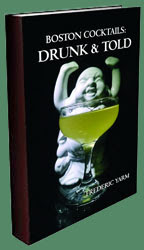 The second talk I attended at Tales of the Cocktail this year was about nutmeg of all things. A talk on a garnish? Well, I was convinced that it was more than just a garnish considering how essential it is to me on topping Cobblers, Tiki, and Flips. And as the speakers described, this valuable spice led to wars and found its way into lots of essential liqueurs and vermouths. Indeed, the presenters here were Jack McGarry of Dead Rabbits in NYC, Peter Vestinos of The Betty in Chicago, and Charlotte Voisey of Hendricks Gin.
The second talk I attended at Tales of the Cocktail this year was about nutmeg of all things. A talk on a garnish? Well, I was convinced that it was more than just a garnish considering how essential it is to me on topping Cobblers, Tiki, and Flips. And as the speakers described, this valuable spice led to wars and found its way into lots of essential liqueurs and vermouths. Indeed, the presenters here were Jack McGarry of Dead Rabbits in NYC, Peter Vestinos of The Betty in Chicago, and Charlotte Voisey of Hendricks Gin.The nutmeg comes from an evergreen tree Myristica fragrans that produces fruits that look like a pale yellow peach. The flesh itself is rather bland and uninteresting, but the kernel inside is where all of the value lies including the flavor and aroma; overall, it is the exact opposite of a peach where you eat the flesh and discard the stone. The two interesting parts are covering or aryl over the seed called mace and the seed itself. Mace has a similar flavor and aroma as nutmeg but is red or dark brown in color. The tree takes 4-7 years to come to fruiting maturity; after that, the fruit falls naturally from the tree.
The panelists bandied about possible roots of the word. Nutmeg is the act of shooting a soccer ball through the legs. Since nutmeg had such great value, there was a lot of trickery in the trade including selling a bag of nutmeg that was something other of similar weight below the top layers. However, they did not cover how Connecticut was the "Nutmeg State" for selling fake nutmeg that was actually just carved wood; that seemed like a significant oversight considering I was born in Milford, CT, and was introduced to that famous concept of spice trickery from an early age.
Nutmeg was originally from the Banda Islands in Indonesia, but through trade and smuggling, the tree began to grow in other areas with similar climate. Trade routes from Europe to the Banda Islands took 3-6 months around the horn of Africa, but the trip was well worth it due to the 60,000% markup at port. It was literally worth more than its weight in gold then. The islands were contested throughout history with Portugal establishing preferred trade instead of occupation in 1577. In 1591, the English form the East India Trading Company, and for 20 years after that, the Dutch and English fight for control of the spice trade. Later, England traded the islands for the Dutch's New Amsterdam (New York). The Bandas began to decline when the English began to replant nutmeg around the Indian Ocean, and the finishing move was the series of late 18th century volcanoes, earthquakes, and tidal waves that destroy the islands. And in the 1790s, the Dutch Trading Company folded as it was too costly to continue the effort. Currently, the leading region for nutmeg is Grenada in the Caribbean which became known as the "Spice Island" and it even has the nutmeg its flag. There are terroir differences between Indonesian and Caribbean nutmegs though.
The culinary uses of nutmeg are well known although different cultures use the spice in different pairings like green vegetables, potatoes, and cheese sauces with more seasonal links to "holiday spices." Health links include aiding stomach ailments, sweating sickness, brain health, oral health, and sleep. Two great stories were shared in this section. First, William Salmon in 1683 explored the warming spice aspect and described a self experiment in which nutmeg oil rubbed on the genitals produced sexual excitation. The second was a German folk tradition where a lady would eat a nutmeg whole, pass it, and grate it over her lover's food. Talk about next level garnish! They also mentioned that nutmeg can be hallucinogenic and described the long lasting euphoria as being between alcohol and marijuana. The dosage for this effect is 3-4 mg per pound of body weight (a low of 1 tsp to a high of 2 Tbsp before going toxic). Wayne Curtis did a great job in describing the experience in detail when he took it himself in an article called My Nutmeg Bender.
Nutmeg graters were gentleman's accessories in the late 18th centuries such as in a necklace or a silver pocket object. If a dandy wanted nutmeg in their punch, they would bring their own and grate it. As nutmeg became cheaper and more common, so were the graters. In the bar, the microplane is key as pepper mills are not coarse enough. Always use fresh nutmeg for certain aspects are lost in the pre-ground spice.
For bartending, nutmeg can hide off aromas such as egg white's wet dog smell and the rare but present use of soft cheese in drinks. Nutmeg occurs in a lot of bar reagents such as Benedictine, Noilly Prat Ambre Vermouth, St. Maria al Monte Amaro, Fernet, Amaro di Angostura, and Root Liqueur. Moreover, nutmeg can be mixed in to make flavored sugars or salts for rims, and since the spice is both water and alcohol soluble, it was recommended to use the nubs left over from scrapings to make bar syrups.
 The 2017 collection of 855 drink recipes, bartender tributes, and essays on hospitality from CocktailVirgin's Frederic Yarm. Available at
The 2017 collection of 855 drink recipes, bartender tributes, and essays on hospitality from CocktailVirgin's Frederic Yarm. Available at  The 2012 collection of 505 drink recipes, techniques, and Boston bar recommendations from Frederic Yarm. Available at
The 2012 collection of 505 drink recipes, techniques, and Boston bar recommendations from Frederic Yarm. Available at 




No comments:
Post a Comment